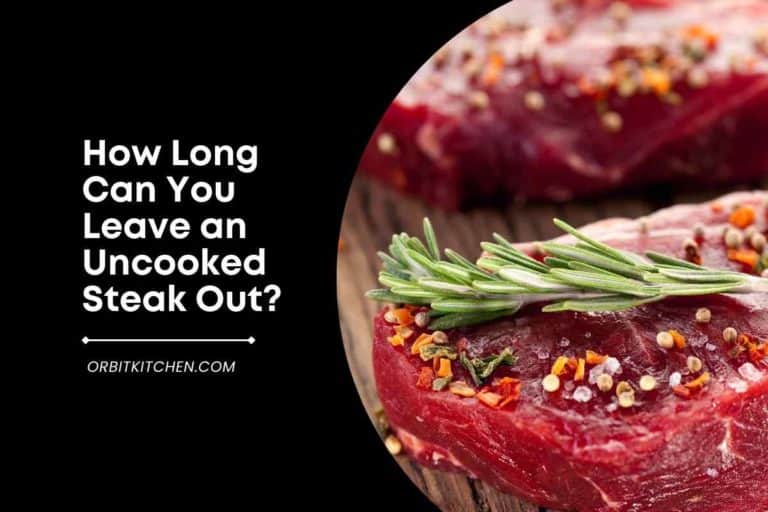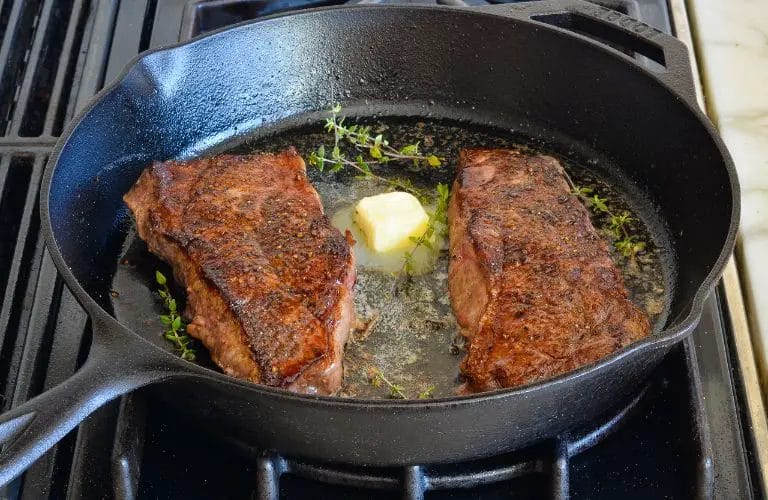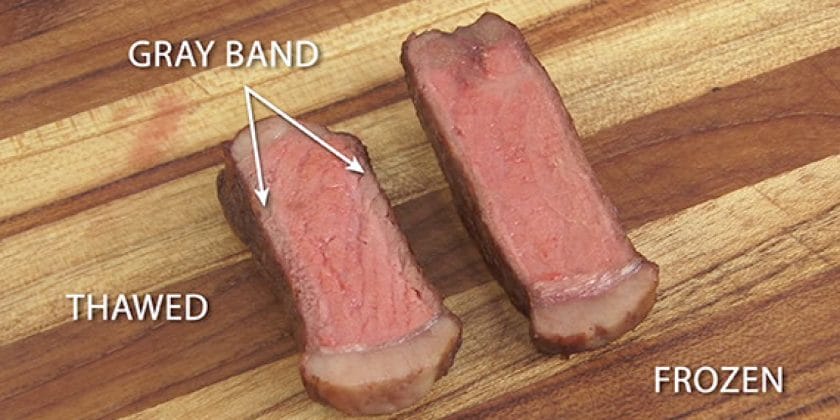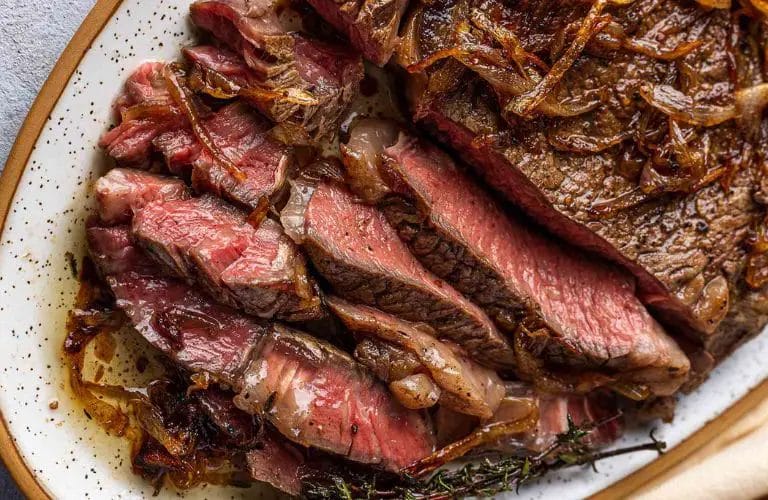When it comes to cooked steak, food safety is of utmost importance. Leaving cooked steak out at room temperature for an extended period can lead to bacterial growth and increase the risk of foodborne illnesses.
It is generally recommended to refrigerate cooked steak within two hours of cooking to prevent bacterial growth. However, if the temperature exceeds 90°F (32°C), the time limit is reduced to one hour. To ensure food safety, it is best to consume or refrigerate cooked steak promptly.

Food Safety Guidelines: How Long Can You Leave Cooked Steak Out?
When it comes to food safety, it is important to follow guidelines to prevent the risk of foodborne illnesses. One common question that arises is how long can you leave cooked steak out.
In this section, we will explore the recommended time frame for leaving cooked steak at room temperature and the potential risks associated with improper handling.
The Danger Zone
Before diving into the specific guidelines for cooked steak, it is crucial to understand the concept of the danger zone.
The danger zone refers to the temperature range in which bacteria can grow rapidly in food, typically between 40°F (4°C) and 140°F (60°C). Therefore, it is essential to keep perishable foods, such as meat, outside of this temperature range to ensure food safety.
Recommended Time for Leaving Cooked Steak Out
As a general rule, it is advised to limit the time cooked steak is left out at room temperature to no more than 2 hours. This timeframe helps minimize bacterial growth and reduces the risk of foodborne illnesses.
If the ambient temperature is above 90°F (32°C), the recommended safe time for leaving cooked steak out decreases to no more than 1 hour. Higher temperatures can accelerate bacterial growth, making it crucial to be even more cautious in warmer environments.
It is important to note that these guidelines are for cooked steak that has been properly stored and cooked to a safe internal temperature.
If the steak has been left out at room temperature for longer than the recommended timeframe, it is advisable to discard it to prevent the risk of foodborne illnesses.
Potential Risks of Improper Handling
Leaving cooked steak out for an extended period can lead to the growth of bacteria, especially if the temperature is within the danger zone. Consuming food that has been contaminated with harmful bacteria can cause food poisoning and other gastrointestinal issues.
Common bacteria that can grow on improperly handled cooked steak include:
- Salmonella: This bacterium is commonly found in raw or undercooked meat and poultry. It can cause symptoms such as diarrhea, abdominal pain, and fever.
- Escherichia coli (E. coli): Certain strains of E. coli can cause severe foodborne illnesses. Symptoms may include diarrhea, stomach cramps, and in some cases, kidney failure.
- Staphylococcus aureus: Staphylococcus aureus can produce toxins that cause food poisoning. Symptoms may include nausea, vomiting, and stomach cramps.
By adhering to the recommended time frame for leaving cooked steak out and practicing proper food handling and storage techniques, you can significantly reduce the risk of foodborne illnesses and ensure the safety of your meals.
Maximizing Freshness: The Ideal Timeframe for Leaving Cooked Steak Out
When it comes to cooking steak, timing is everything. From selecting the right cut to achieving the perfect level of doneness, every step plays a crucial role in ensuring a delicious dining experience.
But what about after the steak is cooked? How long can it be left out before it starts to lose its freshness and become a potential health hazard?
Leaving cooked steak out at room temperature for too long can invite bacteria growth and increase the risk of foodborne illnesses.
However, it’s also important to note that refrigerating hot or warm food can cause condensation, leading to a loss of moisture and the dreaded “soggy steak” effect. So, what is the ideal timeframe for leaving cooked steak out?
The answer lies within the two-hour rule. According to the United States Department of Agriculture (USDA), perishable foods, including cooked steak, should not be left out at room temperature for more than two hours.
This timeframe is based on the principle that bacteria multiply rapidly in the “danger zone” between 40°F (4°C) and 140°F (60°C).
Within this two-hour timeframe, it is crucial to handle cooked steak properly. The steak should be kept in a clean and covered container to prevent any cross-contamination.
Additionally, if the steak has been sitting out for more than an hour, it is advisable to check its internal temperature using a food thermometer. The cooked steak should have an internal temperature of at least 145°F (63°C) to ensure it is safe to consume.
However, it’s important to note that the two-hour rule is not absolute and can vary depending on various factors.
For example, if the room temperature is above 90°F (32°C), perishable foods should not be left out for more than one hour. Similarly, if the steak has been previously refrigerated, the two-hour timeframe may be extended slightly.
Another important consideration is the type of steak and its inherent characteristics. A well-marbled steak, such as a ribeye or New York strip, tends to retain moisture better than a leaner cut like a filet mignon.
This means that a well-marbled steak may be able to withstand being left out for slightly longer without compromising its freshness.
Ultimately, the goal is to maximize the freshness and safety of the cooked steak. If you find yourself in a situation where you need to leave it out for longer than the recommended two hours, it is advisable to err on the side of caution and refrigerate it to minimize the risk of bacterial growth.
When ready to consume, you can simply reheat the steak to your desired temperature and enjoy.

Avoiding Foodborne Illness: Understanding the Risks of Leaving Cooked Steak Unrefrigerated
When it comes to food safety, one of the most important aspects is proper handling and storage of cooked food. Leaving cooked steak unrefrigerated can pose a significant risk of foodborne illness.
In this section, we will explore the dangers of not refrigerating cooked steak and provide tips on how to avoid the risks.
The Danger of Temperature Abuse
Temperature abuse refers to the situation where cooked food is left at an unsafe temperature, allowing bacteria to multiply rapidly. Cooked steak, if not refrigerated promptly, falls within this category.
Bacteria, such as Salmonella and E. coli, can grow at an alarming rate in temperatures between 40°F (4°C) and 140°F (60°C), also known as the “danger zone.”
Leaving cooked steak unrefrigerated for an extended period allows these bacteria to flourish, increasing the risk of food poisoning. It’s important to note that even if the steak is initially cooked to a safe temperature, the bacteria may still be present and can multiply quickly under favorable conditions.
The Role of Microorganisms
Microorganisms, including bacteria, fungi, and viruses, are commonly found on raw meat and poultry. Cooking food thoroughly kills most of these microorganisms, making it safe for consumption.
However, if cooked food is not handled and stored properly, these microorganisms can multiply and cause foodborne illnesses.
Once cooked steak is left unrefrigerated, any residual bacteria can multiply rapidly, reaching dangerous levels within a few hours.
Consuming this steak can lead to symptoms such as nausea, vomiting, diarrhea, abdominal pain, and even more severe complications for individuals with weakened immune systems.
Preventing Foodborne Illness
To prevent foodborne illness and ensure the safety of cooked steak, it’s essential to follow these guidelines:
1. Chill Promptly:
After cooking steak, refrigerate it within two hours. If the ambient temperature is above 90°F (32°C), the time reduces to one hour. Rapid chilling slows down bacterial growth and helps preserve the quality and safety of the meat.
2. Store Properly:
Place the cooked steak in an airtight container or wrap it tightly in aluminum foil or plastic wrap before refrigerating. This prevents exposure to other foods and minimizes the risk of cross-contamination.
3. Use within Safe Timeframe:
Consume the cooked steak within three to four days. After this period, the risk of bacterial growth and foodborne illness increases significantly.
4. Reheat Thoroughly:
If you plan to reheat the cooked steak, ensure it reaches an internal temperature of at least 165°F (74°C) to kill any potential bacteria that may have developed during storage.
5. Practice Hygiene:
Always wash your hands thoroughly with soap and water before and after handling raw or cooked meat. Additionally, clean all utensils, cutting boards, and surfaces that come in contact with the steak to prevent cross-contamination.

Tips for Proper Storage: Best Practices for Handling and Storing Cooked Steak
Once you’ve cooked a delicious steak, it’s important to handle and store it properly to maintain its quality and ensure food safety. Here are some best practices for handling and storing cooked steak:
1. Allow for Proper Cooling
After cooking your steak, allow it to cool for a short period of time before storing it. This helps prevent the growth of bacteria and maintains the steak’s texture. Avoid leaving cooked steak at room temperature for too long, as this can promote bacterial growth.
2. Use Airtight Containers
When storing cooked steak, it’s essential to use airtight containers to prevent exposure to air and moisture. This helps retain the steak’s juiciness and flavor. Consider using resealable plastic bags or airtight containers specifically designed for food storage.
3. Store in the Refrigerator
Refrigeration is key when it comes to storing cooked steak. Place the cooked steak in the refrigerator within two hours of cooking to prevent bacterial growth. Make sure your refrigerator is set to a temperature below 40°F (4°C) to maintain food safety.
4. Label and Date
Properly labeling and dating your stored cooked steak is essential for maintaining freshness and food safety. Use stickers or markers to indicate the date of storage. This helps you keep track of when the steak was cooked and determine its freshness.
5. Consume Within a Few Days
While cooked steak can be stored in the refrigerator, it’s best to consume it within a few days for optimal quality. As time passes, the steak may dry out or develop an off flavor. If you don’t plan on consuming it within this timeframe, consider freezing it for longer storage.
6. Freezing Cooked Steak
If you need to store your cooked steak for a longer period, freezing is a great option. Wrap the steak tightly in plastic wrap or aluminum foil, then place it in a freezer bag or airtight container. Properly stored, cooked steak can last for up to three months in the freezer.
7. Thawing and Reheating
When it’s time to enjoy your frozen cooked steak, it’s important to thaw and reheat it safely. Thaw the steak in the refrigerator overnight or use the defrost function of your microwave. To reheat, use a grill, stovetop, or oven until the internal temperature reaches 165°F (74°C).
8. Quality Check
Before consuming your stored or reheated cooked steak, perform a quality check. Look for any signs of spoilage, such as a foul odor, unusual texture, or discoloration. If the steak appears questionable, it’s best to discard it to avoid the risk of foodborne illness.
9. Don’t Reheat Multiple Times
It’s important to note that reheating cooked steak more than once should be avoided. Each time the steak is reheated, it increases the risk of bacterial growth and compromises its quality. Only reheat the amount of steak you plan to consume to minimize waste and ensure food safety.
By following these tips for proper storage, you can maintain the quality and safety of your cooked steak. Enjoy your delicious meal without any concerns about foodborne illnesses or loss of flavor!

Ensuring Quality: Signs to Determine if Cooked Steak is Safe to Consume
When it comes to cooking steak, ensuring its quality and safety is of utmost importance. Consuming undercooked or spoiled steak can lead to foodborne illnesses and ruin your dining experience.
To guarantee the safety of cooked steak, there are a few signs you can look out for. In this section, we will outline these signs to help you determine if your cooked steak is safe to eat.
1. Temperature
One of the most crucial factors in determining the safety of a cooked steak is its internal temperature. Using a meat thermometer can accurately measure the temperature and ensure that the steak is cooked to the appropriate level. The recommended internal temperatures for cooked steak are as follows:
- Rare: 125°F (52°C)
- Medium Rare: 135°F (57°C)
- Medium: 145°F (63°C)
- Medium Well: 155°F (68°C)
- Well Done: 160°F (71°C) or above
Make sure to insert the thermometer into the thickest part of the steak to get an accurate reading. If the temperature falls below the recommended range, it may indicate that the steak is undercooked and potentially unsafe to eat.
2. Color and Texture
The color and texture of a cooked steak can provide valuable insights into its safety. Here are some guidelines to follow:
- Internal Color: A properly cooked steak should have a consistent internal color. For most cuts, the ideal color is pink or slightly pink in the center. If you notice any gray areas or excessively pink or red meat, it may indicate that the steak is either undercooked or not properly stored.
- Texture: A cooked steak should have a firm yet tender texture. It should not feel excessively tough or mushy. If the texture seems off or inconsistent, it could be an indication of poor quality or improper cooking.
Keep in mind that certain cuts, such as veal or lamb, may have a slightly different internal color due to their natural pigments.
However, if you notice any unusual or unpleasant odors accompanying the color or texture abnormalities, it is best to discard the steak to avoid any potential health risks.
3. Juices
Another sign to determine the safety of a cooked steak is the color of its juices. When properly cooked, the juices of a steak should be clear or slightly pink. If you notice any excessive blood-like or cloudy juices, it could suggest that the steak is undercooked or contaminated.
It’s important to note that the juices escaping from a steak after resting is a normal occurrence. However, if the juices appear abnormal or have an unpleasant smell, it is recommended to err on the side of caution and not consume the steak.
4. Smell
Your sense of smell can be a powerful tool in determining the quality of cooked steak. A properly cooked steak should have a pleasant aroma that is indicative of its flavor and freshness.
If you detect any foul or spoiled smell, it is a strong indication that the steak is not safe to consume. Trust your sense of smell and discard any steak that emits an unpleasant odor.
5. Storage and Handling
Lastly, it is essential to consider the storage and handling practices of the steak before cooking. Be sure to check the expiration date and the condition of the packaging. If the steak has been stored at improper temperatures or for an extended period, it may increase the risk of bacterial growth and spoilage.
Additionally, ensure that the steak is properly thawed before cooking. Thawing steaks at room temperature can lead to the growth of harmful bacteria. It is recommended to thaw steaks in the refrigerator or using the defrost setting on your microwave.

FAQs
How long can you leave cooked steak out?
Cooked steak should not be left out at room temperature for more than 2 hours. Bacteria can grow rapidly in the “danger zone” temperature range of 40°F to 140°F. To prevent foodborne illnesses, it is recommended to refrigerate cooked steak within 2 hours of cooking.
Conclusion:
In conclusion, the duration for leaving cooked steak out at room temperature should not exceed two hours. Beyond this timeframe, the steak becomes susceptible to bacterial growth, leading to the risk of foodborne illnesses.
It is crucial to prioritize food safety by promptly refrigerating or consuming cooked steak to prevent any potential health hazards.
By following proper food handling and storage practices, you can ensure the quality and safety of your cooked steak. Remember to always refrigerate leftovers within two hours of cooking, as this helps to maintain freshness and prevent bacterial contamination.
Enjoy your delicious steak while prioritizing your well-being!

